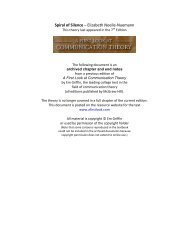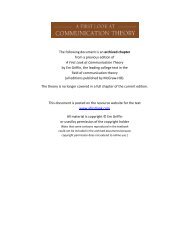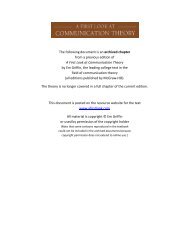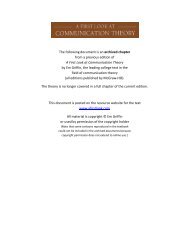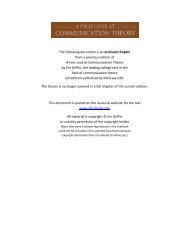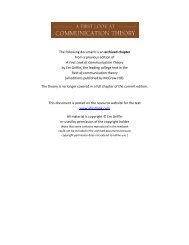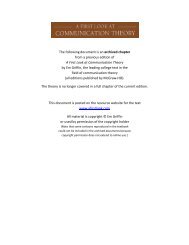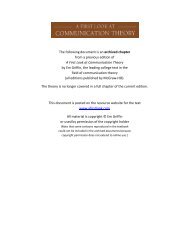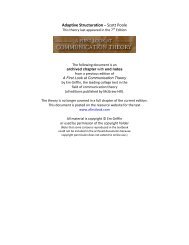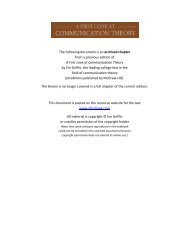Interpersonal Deception Theory (PDF) - A First Look at ...
Interpersonal Deception Theory (PDF) - A First Look at ...
Interpersonal Deception Theory (PDF) - A First Look at ...
- No tags were found...
Create successful ePaper yourself
Turn your PDF publications into a flip-book with our unique Google optimized e-Paper software.
CH:\fT1El\ 7: INTU,PLRSONAL DECl:P'llON THEORY99Although this thinking represents"common sense," the bulk of deception researchshows th<strong>at</strong> these particular nonverbal cues are not reliable indic<strong>at</strong>ors of deception.5 A chuckling, fast-talking person who avoids eye contact is just as likelyto be telling the truth as is someone who displays the socially accepted signs ofsincerity. When tested under controlled labor<strong>at</strong>ory conditions, people rarely aremore than 60 percent accur<strong>at</strong>e in their ability to spot deception, while a just-bychance50 percent detection r<strong>at</strong>e is more common. It appears th<strong>at</strong> P<strong>at</strong> may neverknow for sure wh<strong>at</strong> you did or how you felt on S<strong>at</strong>urday night.AN EMERGENT THEORY OF STRATEGIC INTERACTIONDavid Buller and Judee Burgoon discount the value of highly controlled studiesdesigned to isol<strong>at</strong>e unmistakable cues th<strong>at</strong> people are lying. They agree th<strong>at</strong>human beings are r<strong>at</strong>her poor lie detectors, but they don't think th<strong>at</strong> the typicalone-way communic<strong>at</strong>ion experiment is a helpful way to explore the reason why.They point out th<strong>at</strong> past research has usually involved people listening to scriptedmessages recorded by strangers with whom they've had no chance to interact.This st<strong>at</strong>ic approach to deception ignores communic<strong>at</strong>ion dynamics and focusesinstead on internal thought processes-behind-the-eyes explan<strong>at</strong>ions for liars'manipul<strong>at</strong>ive behavior or the na·ive acceptance of gullible listeners. Buller notesth<strong>at</strong> "rarely is it acknowledged th<strong>at</strong> receivers react to deceivers' messages and th<strong>at</strong>these reactions alter the communic<strong>at</strong>ion exchange and, perhaps, deception's success."6At the start of the 1990s he proclaimed the need for an interpersonal deceptiontheory th<strong>at</strong> wouldexplain the interplay between active deceivers and detectors who communic<strong>at</strong>e withmultiple motives, who behave str<strong>at</strong>egically, whose communic<strong>at</strong>ion behaviors mutuallyinfluence one another to produce a sequence of moves and countermoves, and whosecommunic<strong>at</strong>ion is influenced by the situ<strong>at</strong>ion in which the deception transpires.?<strong>Interpersonal</strong> deception theory is the result. Figure 7-1 is a paraphrased digestof the 18 propositions th<strong>at</strong> appeared in a 1996 issue of Communic<strong>at</strong>ion <strong>Theory</strong>dedic<strong>at</strong>ed to exploring Buller and Burgoon's theory. Although the theorists considertheir model as "work in progress," they arc committed to a set of unchangingassumptions concerning interpersonal communic<strong>at</strong>ion in general, and deceptionin particular. Most of these assumptions surface in their propositions, but twocore ideas stand out.1. <strong>Interpersonal</strong> communic<strong>at</strong>ion is interactive. If the encounter betweenyou and P<strong>at</strong> actually took place, both of you would be active participants, constantlyadjusting your behavior in response to feedback from each other. Wh<strong>at</strong>everstory you tell, you shouldn't expect P<strong>at</strong> to remain verbally and nonverballymute. One way or another, you'll get a response. In order to capture the reality oftwo-way communic<strong>at</strong>ion in flux, I've substituted the term respondent for the morepassive term listener in my paraphrase of Buller and Burgoon's propositions.Interaction, r<strong>at</strong>her than individuality, is <strong>at</strong> the core of their theory.



